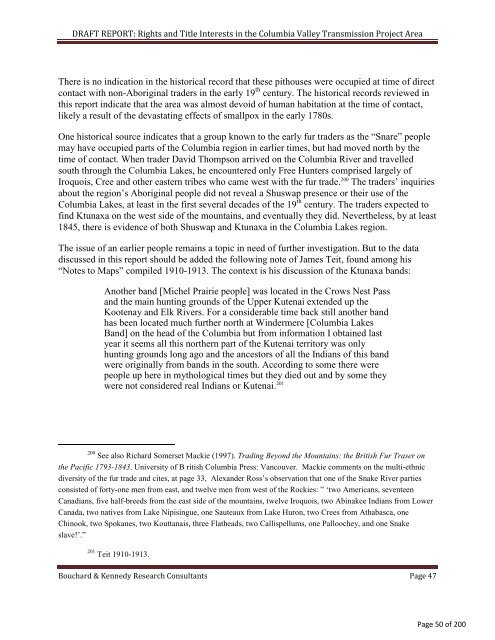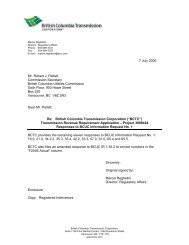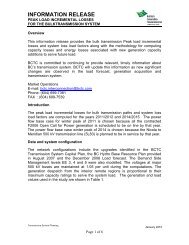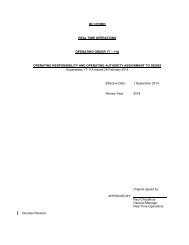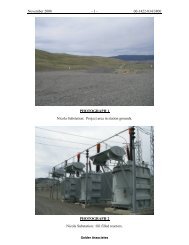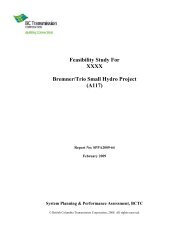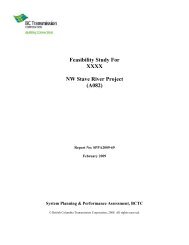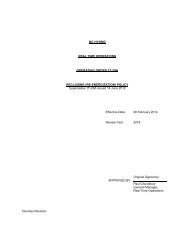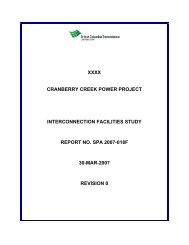Evidence on the Adequacy of First Nations Consultation - BC Hydro ...
Evidence on the Adequacy of First Nations Consultation - BC Hydro ...
Evidence on the Adequacy of First Nations Consultation - BC Hydro ...
You also want an ePaper? Increase the reach of your titles
YUMPU automatically turns print PDFs into web optimized ePapers that Google loves.
DRAFT REPORT: Rights and Title Interests in <strong>the</strong> Columbia Valley Transmissi<strong>on</strong> Project Area<br />
There is no indicati<strong>on</strong> in <strong>the</strong> historical record that <strong>the</strong>se pithouses were occupied at time <strong>of</strong> direct<br />
c<strong>on</strong>tact with n<strong>on</strong>-Aboriginal traders in <strong>the</strong> early 19 th century. The historical records reviewed in<br />
this report indicate that <strong>the</strong> area was almost devoid <strong>of</strong> human habitati<strong>on</strong> at <strong>the</strong> time <strong>of</strong> c<strong>on</strong>tact,<br />
likely a result <strong>of</strong> <strong>the</strong> devastating effects <strong>of</strong> smallpox in <strong>the</strong> early 1780s.<br />
One historical source indicates that a group known to <strong>the</strong> early fur traders as <strong>the</strong> “Snare” people<br />
may have occupied parts <strong>of</strong> <strong>the</strong> Columbia regi<strong>on</strong> in earlier times, but had moved north by <strong>the</strong><br />
time <strong>of</strong> c<strong>on</strong>tact. When trader David Thomps<strong>on</strong> arrived <strong>on</strong> <strong>the</strong> Columbia River and travelled<br />
south through <strong>the</strong> Columbia Lakes, he encountered <strong>on</strong>ly Free Hunters comprised largely <strong>of</strong><br />
Iroquois, Cree and o<strong>the</strong>r eastern tribes who came west with <strong>the</strong> fur trade. 200 The traders’ inquiries<br />
about <strong>the</strong> regi<strong>on</strong>’s Aboriginal people did not reveal a Shuswap presence or <strong>the</strong>ir use <strong>of</strong> <strong>the</strong><br />
Columbia Lakes, at least in <strong>the</strong> first several decades <strong>of</strong> <strong>the</strong> 19 th century. The traders expected to<br />
find Ktunaxa <strong>on</strong> <strong>the</strong> west side <strong>of</strong> <strong>the</strong> mountains, and eventually <strong>the</strong>y did. Never<strong>the</strong>less, by at least<br />
1845, <strong>the</strong>re is evidence <strong>of</strong> both Shuswap and Ktunaxa in <strong>the</strong> Columbia Lakes regi<strong>on</strong>.<br />
The issue <strong>of</strong> an earlier people remains a topic in need <strong>of</strong> fur<strong>the</strong>r investigati<strong>on</strong>. But to <strong>the</strong> data<br />
discussed in this report should be added <strong>the</strong> following note <strong>of</strong> James Teit, found am<strong>on</strong>g his<br />
“Notes to Maps” compiled 1910-1913. The c<strong>on</strong>text is his discussi<strong>on</strong> <strong>of</strong> <strong>the</strong> Ktunaxa bands:<br />
Ano<strong>the</strong>r band [Michel Prairie people] was located in <strong>the</strong> Crows Nest Pass<br />
and <strong>the</strong> main hunting grounds <strong>of</strong> <strong>the</strong> Upper Kutenai extended up <strong>the</strong><br />
Kootenay and Elk Rivers. For a c<strong>on</strong>siderable time back still ano<strong>the</strong>r band<br />
has been located much fur<strong>the</strong>r north at Windermere [Columbia Lakes<br />
Band] <strong>on</strong> <strong>the</strong> head <strong>of</strong> <strong>the</strong> Columbia but from informati<strong>on</strong> I obtained last<br />
year it seems all this nor<strong>the</strong>rn part <strong>of</strong> <strong>the</strong> Kutenai territory was <strong>on</strong>ly<br />
hunting grounds l<strong>on</strong>g ago and <strong>the</strong> ancestors <strong>of</strong> all <strong>the</strong> Indians <strong>of</strong> this band<br />
were originally from bands in <strong>the</strong> south. According to some <strong>the</strong>re were<br />
people up here in mythological times but <strong>the</strong>y died out and by some <strong>the</strong>y<br />
were not c<strong>on</strong>sidered real Indians or Kutenai. 201<br />
200 See also Richard Somerset Mackie (1997). Trading Bey<strong>on</strong>d <strong>the</strong> Mountains: <strong>the</strong> British Fur Traser <strong>on</strong><br />
<strong>the</strong> Pacific 1793-1843. University <strong>of</strong> B ritish Columbia Press: Vancouver. Mackie comments <strong>on</strong> <strong>the</strong> multi-ethnic<br />
diversity <strong>of</strong> <strong>the</strong> fur trade and cites, at page 33, Alexander Ross’s observati<strong>on</strong> that <strong>on</strong>e <strong>of</strong> <strong>the</strong> Snake River parties<br />
c<strong>on</strong>sisted <strong>of</strong> forty-<strong>on</strong>e men from east, and twelve men from west <strong>of</strong> <strong>the</strong> Rockies: ” ‘two Americans, seventeen<br />
Canadians, five half-breeds from <strong>the</strong> east side <strong>of</strong> <strong>the</strong> mountains, twelve Iroquois, two Abinakee Indians from Lower<br />
Canada, two natives from Lake Nipisingue, <strong>on</strong>e Sauteaux from Lake Hur<strong>on</strong>, two Crees from Athabasca, <strong>on</strong>e<br />
Chinook, two Spokanes, two Kouttanais, three Fla<strong>the</strong>ads, two Callispellums, <strong>on</strong>e Palloochey, and <strong>on</strong>e Snake<br />
slave!’.”<br />
201 Teit 1910-1913.<br />
Bouchard & Kennedy Research C<strong>on</strong>sultants Page 47<br />
Page 50 <strong>of</strong> 200


